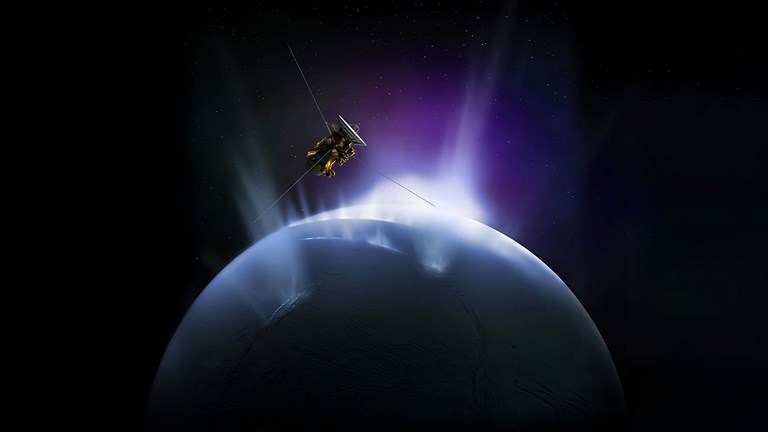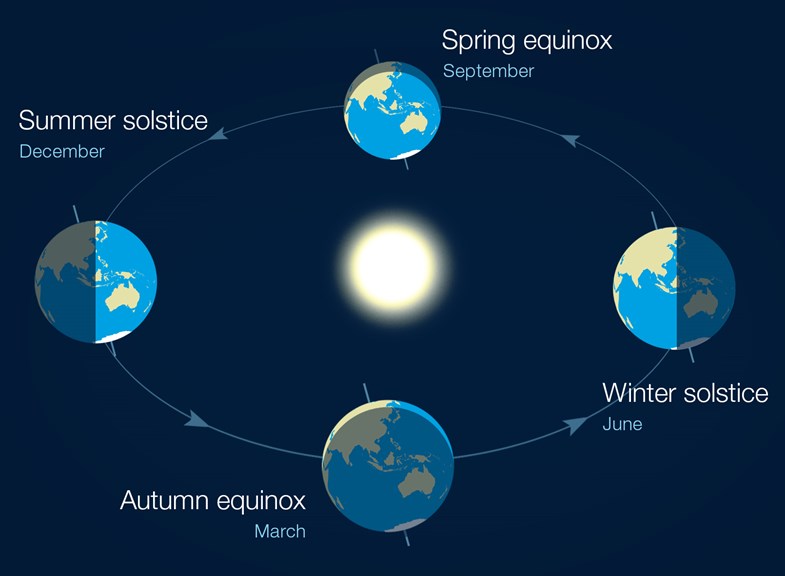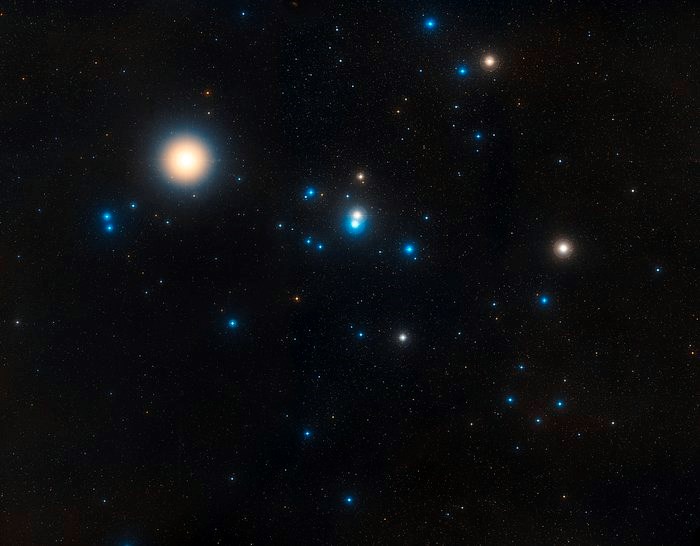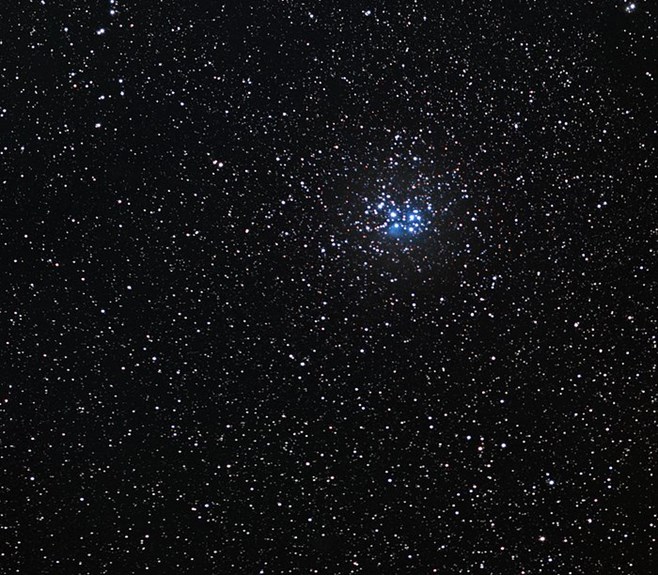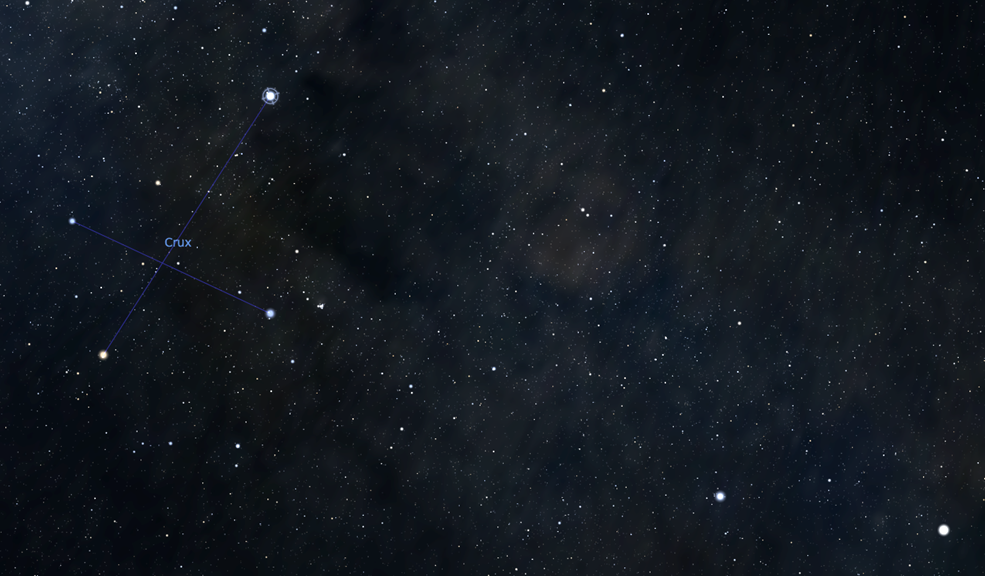Skynotes: December 2023
Upcoming events
Summer Solstice
Earth will have its solstices on Thursday 22nd – Summer Solstice in the Southern Hemisphere and Winter Solstice in the Northern Hemisphere. From the Latin meaning the standing still of the sun this is when the path and position of the Sun in the sky reaches its furthest extremes. It seems to ‘pause’ before beginning its six-month reverse to the time of the next solstice.
At the summer solstice the Sun will rise and set at its most southerly points on the horizon. With Earth’s axis tilted at 23.5 degrees the southern hemisphere will be leaning towards the sun, its rays will be almost perpendicular giving maximum heat to oceans and ground, the sun’s path will be the highest and longest of the year, and daylight hours will therefore be greatest.
The opposite conditions of winter will apply in the northern hemisphere where that hemisphere will be leaning away from the sun, sunlight will be at a shallow angle giving least warmth, the sun’s path will be low and short, and daylight hours will be the shortest of the year.
Explore more
Bureau of Meteorology – Solstices and Equinoxes
Geosciences Australia – Summer and Winter Solstices
Melbourne Sun times
| Date | Rise | Set | Day length | Solar noon* |
|---|---|---|---|---|
| Friday 1st | 5:52am | 8:26pm | 14:34 hours | 1:08pm |
| Monday 11th | 5:51am | 8:35pm | 14:43 hours | 1:13pm |
| Thursday 21 | 5:54am | 8:41pm | 14:47 hours | 1:17pm |
| Sunday 31 | 6:00am | 8:45pm | 14:44 hours | 1:22pm |
*When the sun is at its highest, crossing the meridian or local longitude.
Moon phases
| Phase | Date |
|---|---|
| Third Quarter | Tuesday 5th |
| New Moon | Wednesday 13th |
| First Quarter | Wednesday 20th |
| Full Moon | Wednesday 27th |
Moon distances
Tuesday 7th is Lunar apogee (furthest from Earth) at 404,346 km.
Sunday 17th is Lunar perigee (closest to Earth) at 367,901 km.
Planets
Mercury is too near the Sun to be seen from Melbourne this month.
Venus is bright as the ‘morning star’ rising in the east around 3.30am before fading in the early dawn light.
Mars has completed its pass behind the sun, its solar conjunction, when it was ‘conjoined’ with the Sun from our view on Earth. It is still too close to the Sun to be seen this month but the Red Planet will reappear as a visible object next month.
Jupiter continues as an easily seen planet from 9pm in the north. It will move across the northern sky and set in the west by 2.30am.
Saturn, faint and yellowish, can be seen for part of the night this month in the west from 9.30pm before setting by 1am.
Meteors
The Geminids run from the 4th to 17th peaking on the night of 13th/14th and appear in Gemini in the north-east. Most meteor showers result from Earth intersecting particles shed by comets along their orbits around the Sun. However, Geminids are connected with the asteroid Phaethon. In good viewing conditions up to 120 meteors per hour could be seen.
See
Stars and constellations
In the East
Summer offers a rich selection of features to enjoy from north-east to south-east. Some constellations used by astronomers appear upside down in the southern hemisphere. Travelling from one hemisphere to the other will change the orientation of a star pattern as the viewing angle inverts the star pattern, which will be case for the Moon as well.
Sirius, the principal star in the constellation Canis Major (Greater Dog), sits directly east in our evening skies. To the left is Orion (the hunter) with three bright stars forming a line as his belt. In our southern upside view, his two shoulders are Bellatrix at lower left and red-giant star Betelguese at lower right. His two feet are marked by Rigel at upper left and Saiph upper right.
Well known to many is the local asterism, The Saucepan, and being ‘right way up’ its base is Orion’s belt and its handle forms the hunter’s scabbard.
In the North
Taurus (the bull) can be seen by finding the red giant star Aldebaran which marks its red eye and is one corner of an inverted V which forms the bull’s head. At 65 light years away, Aldebaran is closer to us than the other stars that are at 150 light years and form an open cluster known as the Hyades.
To the left of Aldebaran is the beautiful Pleiades star cluster or Seven Sisters.
In many widely separated cultures this open cluster often represents a group of women, sometimes connected to the figure of a man seen in Orion.
In the West
in the south-west sits Sagittarius (the centaur-archer). Low in the west is Capricornus (the sea goat), and higher up is bright Formalhaut (Alpha Piscis Austrini) the principal star in Piscis Austrinus (Southern Fish).
In the South
Low in the south and upside down at this time of the year is Crux (Southern Cross) with the Pointers (Alpha and Beta Centauri) to its right guiding the eye to Crux. Our galaxy’s two small neighbouring galaxies, the Large and Small Magellanic Clouds, sit high in the south.
Behind the Southern Cross and stretching from south to north is the Milky Way’s dense arc of stars containing large interstellar dust clouds that block our visible light view of more distant stars. Famous among them is the Coal Sack that sits beside the Southern Cross.
International Space Station
ISS orbits every 90 minutes at an average distance of 400 km appearing like a bright star moving slowly across the night sky. Here are some of the brightest passes expected this month over Melbourne, including two on one day.
Evening
Saturday 9th
10:26pm to 10:33pm. North-West to South-East
Sunday 10th
9:38pm to 9:44pm. North-North-West to East-South-East
Morning and Evening
Tuesday 12th
4:55am to 5:02am South-West to North-East
9:36pm to 9:43pm West-North-West to South-East
Heavens Above gives predictions for visible passes of space stations and major satellites, live sky views and 3D visualisations. Be sure to first enter your location under ‘Configuration’.
On this day
1st 1922, solutions to Einstein’s equations for space-time and mass-energy are developed by Alexander Friedman.
2nd 1915, Einstein’s General Relativity is published on gravity-acceleration equivalence and space-time curvature.
2nd 1971, Mars 3 (USSR) - first soft landing and return of data from Mars.
3rd 2014, JAXA explorer Hyabusa 2 (Japan) is launched to asteroid Ryugu with a planned sample return to Earth.
3rd 1973, Pioneer 10 (USA) makes the first fly-by of Jupiter and returns the first close-up images of the planet.
7th 1676, Danish astronomer Ole Remer calculates first accurate speed of light by observing eclipses of moon Io by Jupiter.
7th-19th 1972, Apollo 17 (USA): last moon mission and longest on lunar surface at 74 hours, 59 mins by astronauts Eugene Cernan and Harrison Schmitt.
7th 1995, Galileo probe (USA) makes first orbit of Jupiter after six years in transit.
8th 1977, HEAO 1 (USA), High Energy Astro Observatory, is launched into orbit.
8th 2010, SpaceX is first private company to launch, orbit and recover a spacecraft, its SpaceX Dragon.
10th 1993, the faulty optics of the Hubble Space Telescope (USA) are repaired.
11th 1863, birth of astronomer Annie Jump Canon compiler of Draper Star Catalog.
12th 1970, Explorer 42 (USA) satellite is launched to study x-rays.
14th 1546, Danish astronomer Tycho Brahe, whose data aided Kepler in his laws of planetary motion, is born.
14th 1962, Mariner 2 (USA) is first probe to fly past Venus.
15th 1970, Venera 7 (USSR) is first probe to land safely on another planet, and first to return data, when it arrived at Venus.
21st 1988, Cosmonauts Vladimir Titov and Musa Manarov make longest space flight (365 days, 22 hours, 39 min) on Soviet space station Mir.
21st-27th 1968, Apollo 8 (USA) first manned craft to orbit the Moon - 10 orbits at 110km from the surface, imaging landing sites and the iconic ‘Earthrise’ photo.
24th 1979, ESA’s first launch vehicle Ariene 1 (France) orbits its first test satellite CAT1.
27th 1571, discoverer of laws of planetary motion, Johannes Kepler, is born.
28th 1612, Neptune is observed for the first time but mistaken as a star by Galileo.
30th 1924, astronomer Edwin Hubble (USA) announces faint ‘nebulae’ are actually galaxies beyond our own.

